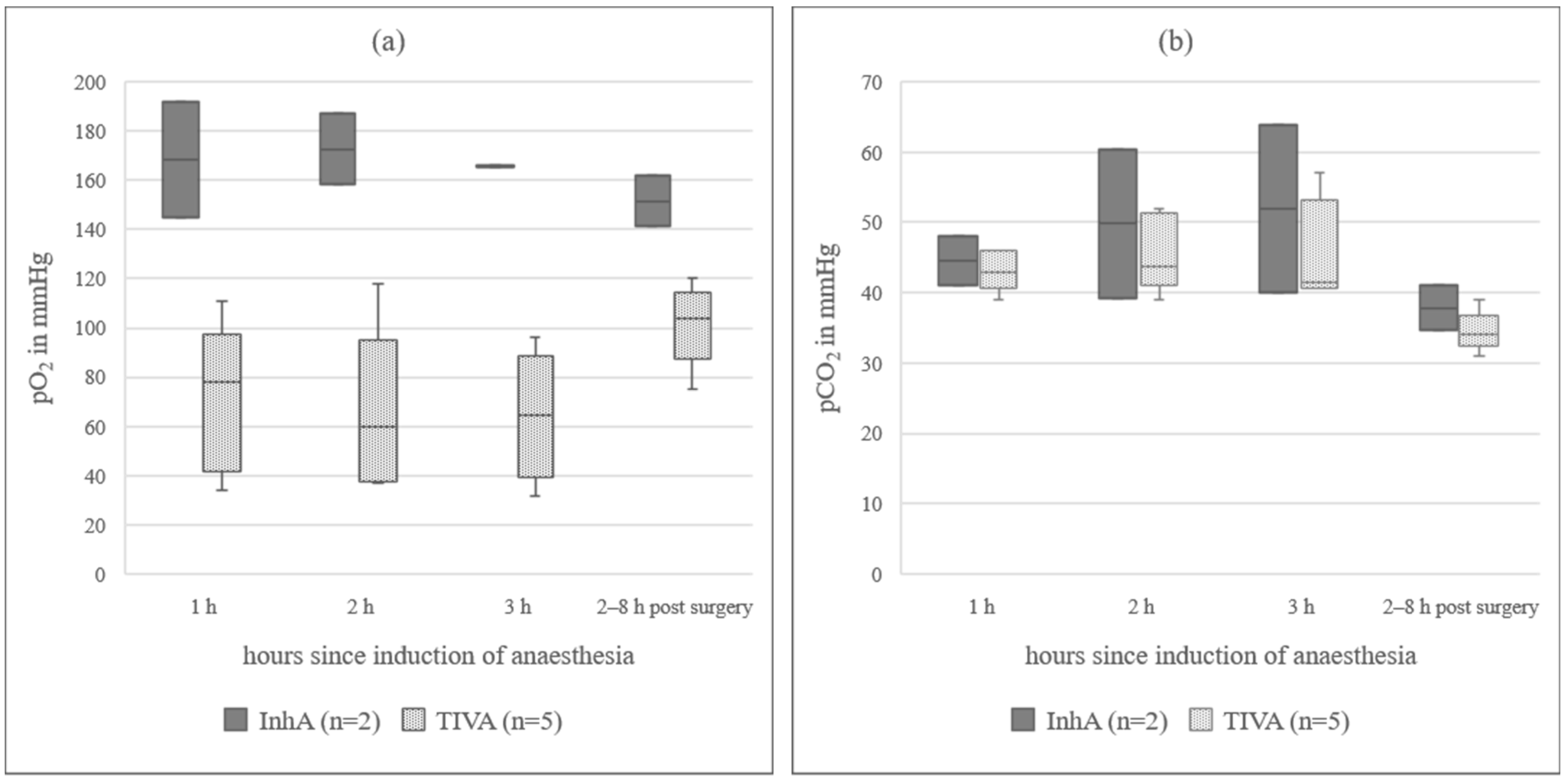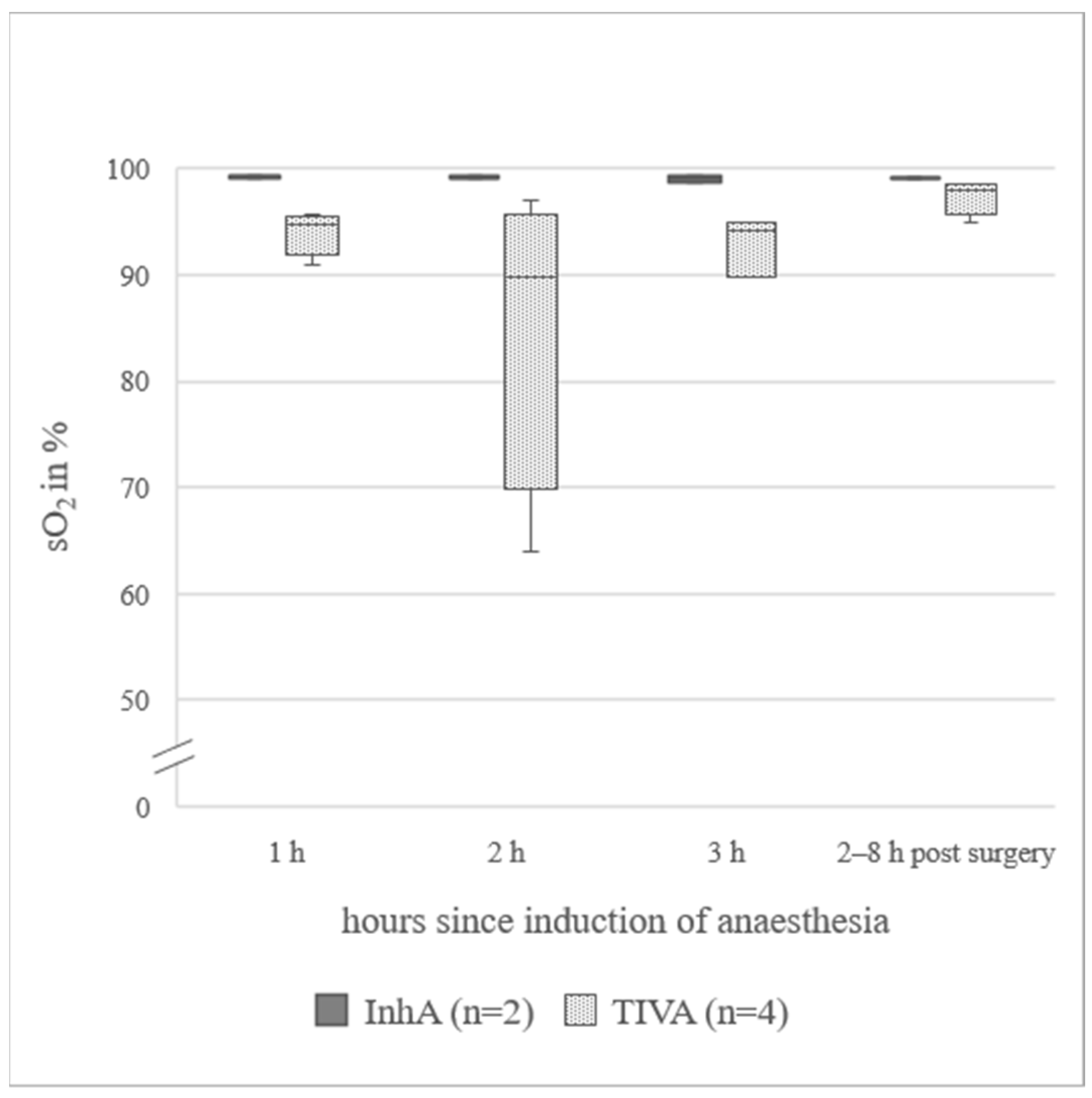Analysis of pH and Electrolytes in Blood and Electrolytes in Ruminal Fluid, including Kidney Function Tests, in Sheep Undergoing General Anaesthesia for Laparotomy
Abstract
Simple Summary
Abstract
1. Introduction
2. Materials and Methods
2.1. Anaesthesia and Pain Management
2.1.1. Setting: Inhalational Anaesthesia (InhA)
2.1.2. Setting: Total Intravenous Anaesthesia (TIVA)
2.2. Preparation of the Animal
2.3. Surgery
2.4. Sampling
2.5. Analysis of the Samples
2.6. Analysis of Data
3. Results
3.1. General Data on Anaesthesia
3.2. Blood Gas Analysis
3.3. Blood Analysis in the Laboratory
3.4. Parameters in Ruminal Fluid
3.5. Parameters in Urine
4. Discussion
4.1. General Data on Anaesthesia
4.2. Blood Gas Analysis
4.3. Blood Analysis in the Laboratory
4.4. Parameter in Ruminal Fluid
4.5. Parameters in Urine
5. Conclusions
Supplementary Materials
Author Contributions
Funding
Institutional Review Board Statement
Informed Consent Statement
Data Availability Statement
Acknowledgments
Conflicts of Interest
Abbreviations
References
- Schultz, L.G.; Tyler, J.W.; Moll, H.D.; Constantinescu, G.M. Surgical approaches for cesarean section in cattle. Can. Veter. J. Rev. Veter. Can. 2008, 49, 565–568. [Google Scholar]
- Ennen, S.; Scholz, M.; Voigt, K.; Failing, K.; Wehrend, A. Puerperal development of ewes following dystocia: A retrospective analysis of two approaches to caesarean section. Veter. Rec. 2013, 172, 554. [Google Scholar] [CrossRef] [PubMed]
- Lin, H.; Walz, P. Farm Animal Anesthesia; Wiley: Hoboken, NJ, USA, 2014. [Google Scholar]
- Voigt, K.; Najm, N.; Zablotski, Y.; Rieger, A.; Vassiliadis, P.; Steckeler, P.; Schabmeyer, S.; Balasopoulou, V.; Zerbe, H. Factors associated with ewe and lamb survival, and subsequent reproductive performance of sheep undergoing emergency caesarean section. Reprod. Domest. Anim. 2021, 56, 120–129. [Google Scholar] [CrossRef]
- Waage, S.; Wangensteen, G. Short-term and long-term outcomes of ewes and their offspring after elective cesarean section. Theriogenology 2013, 79, 486–494. [Google Scholar] [CrossRef] [PubMed]
- Wagener, M.G.; Grimm, L.M.; Koch, W.; Blume, R.; Von Altrock, A.; Meilwes, J.; Punsmann, T.; Schwennen, C.; Kloker, A.; Ganter, M. Volvulus der Kolonscheibe bei einem Zwergziegenbock. Tierarztl Prax Ausg G Grosstiere Nutztiere 2019, 47, 49–54. [Google Scholar] [CrossRef]
- Rousseau, M.; Anderson, D.E.; Rozell, T.G.; Hand, J.M.; Faris, B.R. Comparison of polyglactin-910 and polydioxanone for closure of the linea alba following caudal ventral midline laparotomy in sheep. Can. Veter. J. Rev. Veter. Can. 2015, 56, 959–963. [Google Scholar]
- Breves, G.; Diener, M.; Gäbel, G.; von Engelhardt, W. Ernährung und Energiehaushalt. In Physiologie Der Haustiere, 5th ed.; Enke Verlag: Bayern, Germany, 2015. [Google Scholar]
- Macfarlane, W.; Morris, R.; Howard, B.; McDonald, J.; Budtz-Olsen, O. Water and electrolyte changes in tropical Merino sheep exposed to dehydration during summer. Aust. J. Agric. Res. 1961, 12, 889–912. [Google Scholar] [CrossRef]
- Musk, G.C.; Kemp, M.W. Pregnant sheep develop hypoxaemia during short-term anaesthesia for caesarean delivery. Lab. Anim. 2018, 52, 497–503. [Google Scholar] [CrossRef]
- Musk, G.C.; Kershaw, H.; Kemp, M.W. Oxygen delivery by mask improves the PaO2 of pregnant ewes during short term anaesthesia for caesarean delivery of preterm lambs. Veter. Anim. Sci. 2021, 12, 100177. [Google Scholar] [CrossRef]
- Grimm, L.M.; Humann-Ziehank, E.; Zinne, N.; Zardo, P.; Ganter, M. Analysis of pH and electrolytes in blood and ruminal fluid, including kidney function tests, in sheep undergoing long-term surgical procedures. Acta Veter. Scand. 2021, 63, 43. [Google Scholar] [CrossRef]
- Leonhard-Marek, S.; Stumpff, F.; Martens, H. Transport of cations and anions across forestomach epithelia: Conclusions from in vitro studies. Animal 2010, 4, 1037–1056. [Google Scholar] [CrossRef] [PubMed]
- Al-Ramamneh, D.; Riek, A.; Gerken, M. Effect of water restriction on drinking behaviour and water intake in German black-head mutton sheep and Boer goats. Animal 2012, 6, 173–178. [Google Scholar] [CrossRef] [PubMed]
- Bickhardt, K.; Düngelhoef, R. Clinical studies of kidney function in sheep. I. Methods and reference values of healthy animals. DTW Dtsch. Tierarztliche Wochenschr. 1994, 101, 463–466. [Google Scholar]
- Bickhardt, K. Clinical studies of kidney function in sheep. II. Effect of pregnancy, lactation and feed restriction and metabolic diseases on kidney function. DTW Dtsch. Tierarztliche Wochenschr. 1994, 101, 467–471. [Google Scholar]
- Bickhardt, K.; Ganter, M.; Steinmann Chavez, C. Clinical Kidney Function Studies in Sheep. Iii. Pathologic Function Changes in Nephropathies of Sheep and in Urolithiasis of Rams and Billy Goat. Dtsch Tierarztl Wochenschr 1995, 102, 59–64. [Google Scholar]
- Atherton, J.C. Regulation of fluid and electrolyte balance by the kidney. Anaesth. Intensiv. Care Med. 2006, 7, 227–233. [Google Scholar] [CrossRef]
- Hodkinson, O.; Dawson, L. Practical Anaesthesia and Analgesia in Sheep, Goats and Calves. In Practice; Wiley: Hoboken, NJ, USA, 2007; Volume 29, pp. 596–603. [Google Scholar]
- Bostedt, H.; Ganter, M.; Hiepe, T. Klinik der Schaf- und Ziegenkrankheiten. Anästhesie/Analgesie; Ganter, M., Ed.; Georg Thieme Verlag KG: Stuttgart, Gemrnay, 2019. [Google Scholar]
- Ganter, M.; Steinmann-Chavez, C.; Wendt, M.; Hülsmann, H.G.; Waldmann, K.-H. A Practical Vein Catheter for Small Ru-minants (Short Report). Dtsch Tierärztl Wschr 1990, 97, 44–45. [Google Scholar]
- Kampmeier, T.; Arnemann, P.; Heßler, M.; Rehberg, S.; Morelli, A.; Westphal, M.; Lange, M.; Van Aken, H.; Ertmer, C. Provision of physiological data and reference values in awake and anaesthetized female sheep aged 6–12 months. Veter. Anaesth. Analg. 2017, 44, 518–528. [Google Scholar] [CrossRef] [PubMed]
- Peers, A.; Mellor, D.; Wintour, E.; Dodic, M. Blood pressure, heart rate, hormonal and other acute responses to rubber-ring castration and tail docking of lambs. N. Z. Veter. J. 2002, 50, 56–62. [Google Scholar] [CrossRef] [PubMed]
- Ganter, M.; Bostedt, H.; Humann-Ziehank, E. Klinik Der Schaf- und Ziegenkrankheiten. Untersuchungsmethoden und Diagnostik; Georg Thieme Verlag KG: Stuttgard, Germany, 2021. [Google Scholar]
- Musk, G.C.; Kershaw, H.; Kemp, M.W. Anaemia and Hypoproteinaemia in Pregnant Sheep during Anaesthesia. Animals 2019, 9, 156. [Google Scholar] [CrossRef]
- Udegbunam, R.I.; Umeh, L.A.; Udegbunam, S.O. The Effect of Ketamine Hydrochloride on the Erythrocytic Indices of Sple-nectomized Dogs. Anim. Sci. Report. 2009, 3, 114–117. [Google Scholar]
- Wolf, S.J.; Reske, A.P.; Hammermüller, S.; Costa, E.L.V.; Spieth, P.M.; Hepp, P.; Carvalho, A.; Kraßler, J.; Wrigge, H.; Amato, M.B.P.; et al. Correlation of Lung Collapse and Gas Exchange - A Computer Tomographic Study in Sheep and Pigs with Atelectasis in Otherwise Normal Lungs. PLoS ONE 2015, 10, e0135272. [Google Scholar] [CrossRef] [PubMed][Green Version]
- Rehm, M.; Conzen, P.F.; Peter, K.; Finsterer, U. Das Stewart-Modell. Anaesthesist 2004, 53, 347–357. [Google Scholar] [CrossRef]
- Rodríguez, M.; Alexander, D.; Espinosa, O.J.O. Hypochloremic Metabolic Alkalosis or Strong Ion Alkalosis: A Review. (Eng-lish). Rev. Med. Vet. 2016, 32, 131. [Google Scholar]
- Jorch, G.; Hübler, A. Hypoglykämien. In Neonatologie, 1st ed.; Thieme: Stuttgart, Germany, 2010. [Google Scholar]
- Rutter, L.M.; Manns, J.G. Changes in Metabolic and Reproductive Characteristics Associated with Lactation and Glucose Infusion in the Postpartum Ewe. J. Anim. Sci. 1986, 63, 538–545. [Google Scholar] [CrossRef]
- Sklan, D.; Hurwitz, S. Movement and Absorption of Major Minerals and Water in Ovine Gastrointestinal Tract. J. Dairy Sci. 1985, 68, 1659–1666. [Google Scholar] [CrossRef]
- Iguchi, N.; Kosaka, J.; Booth, L.C.; Iguchi, Y.; Evans, R.; Bellomo, R.; May, C.N.; Lankadeva, Y.R. Renal perfusion, oxygenation, and sympathetic nerve activity during volatile or intravenous general anaesthesia in sheep. Br. J. Anaesth. 2019, 122, 342–349. [Google Scholar] [CrossRef] [PubMed]
- Galatos, A.D. Anesthesia and Analgesia in Sheep and Goats. Veter. Clin. N. Am. Food Anim. Pr. 2011, 27, 47–59. [Google Scholar] [CrossRef] [PubMed]



| Animal | Anaesthesia | Pregnancy status | Ketamine | Xylazine |
|---|---|---|---|---|
| No. 1 | InhA | NPE | yes | yes |
| No. 2 | ||||
| No. 3 | ||||
| No. 4 | PE | |||
| No. 5 | no | |||
| No. 6 | ||||
| No. 7 | ||||
| No. 8 | TIVA | NPE | yes | yes |
| No. 9 | ||||
| No. 10 | ||||
| No. 11 | ||||
| No. 12 | ||||
| No. 13 | ||||
| No. 14 | PE |
| HR in Beats Per Minute | RR in Breaths Per Minute | |||
|---|---|---|---|---|
| TIVA | InhA | TIVA | InhA | |
| hour 1 | 100(64–120) | 88(76–96) | 64(54–96) | 14(12–53) |
| hour 2 | 64(48–100) | 104(84–120) | 60(44–64) | 12(12–42) |
| hour 3 | 84(55–100) | 112(76–118) | 56(38–61) | 12(12–40) |
| InhA (n = 7) | TIVA (n = 6) | |||||
|---|---|---|---|---|---|---|
| Value | Hour 1 | Hour 2 | Hour 3 | Hour 1 | Hour 2 | Hour 3 |
| Sodium in mmol/L | 110.2 ± 11 | 109.5 ± 15.3 | 107 ± 11.7 | 107.6 ± 8.5 | 109 ± 11.2 | 111.8 ± 4.3 |
| Potassium in mmol/L | 20.8(17.5–23.5) | 22.9(18.4–26.4) | 23.6(18.4–34.8) | 23.3(21.5–27.2) | 24.9(19.5–28.1) | 23.7(18.2–36.7) |
| Calcium in mmol/L | 0.9(0.8–1.1) | 1.3(0.8–1.8) | 1.3(0.8–2.1) | 1(0.6–1.3) | 1.1(0.8–1.6) | 0.9(0.9–1.3) |
| Phosphate in mmol/L | 17(14.1–20.5) | 17.4(14.5–24.3) | 16.3(13.7–26.9) | 28.9(18.3–31.3) | 26.1(18.7–31.1) | 29.1(18.2–33.8) |
| L-Lactate in mmol/L | 0.11(0.07–0.15) | 0.11(0.06–0.13) | 0.11(0.09–0.25) | 0.11(0.08–0.17) | 0.14(0.1–0.19) | 0.14(0.12–0.22) |
| D-Lactate in mmol/L | 0.1(0.09–0.13) | 0.1(0.07–0.14) | 0.12(0.11–0.17) | 0.11(0.09–0.15) | 0.13(0.11–0.19) | 0.09(0.07–0.14) |
| InhA (n = 7) | TIVA (n = 7) | ||||||
|---|---|---|---|---|---|---|---|
| Value | Hour 1 | Hour 2 | Hour 3 | Hour 1 | Hour 2 | Hour 3 | Reference Values * |
| Crea_cl in mL/min/kg | 1.8(1.6–2.1) | 1.7(1.6–2.1) | 1.7(1.3–2) | 1.6(1.4–1.7) | 1.5(1.4–1.7) | 1.5(1.3–1.6) | 1.14–2.3 |
| FE Calcium in % | 0.8(0.1–1.6) | 0.2(0.2–1.7) | 0.7(0.1–1.6) | 0.2(0.1–1.8) | 0.8(0.1–1.6) | 0.3(0–0.7) | 0.03–8.9 |
| FE Phosphate in % | 0.2(0.1–2) | 2.1(0.1–4.6) | 0.2(0–2.4) | 0.4(0.2–1.3) | 1.9(0.2–3.0) | 1.1(0.7–2.6) | 0.01–3.39 |
| FE Sodium in % | 0.9(0–1.3) | 0.9(0.2–1.8) | 0.5(0.1–1.2) | 0.4(0.2–1.1) | 0.4(0.3–2.7) | 0.6(0.3–1.8) | 0.04–1.22 |
| FE Potassium in % | 56.9(46.1–72.1) | 66.2(39.3–93.2) | 33.1(16.7–52.8) | 39.7(34.1–68) | 74.3(37.7–104.1) | 64.1(30.4–85.6) | 12.2–96.0 |
| FE Water in % | 1.4(0.9–5.4) | 1.5(0.7–7.6) | 1.0(0.5–6.3) | 2(0.8–4.5) | 3.3(1.5–5.1) | 2.8(1.9–4.1) | 0.2–2.5 |
| GGT in U/L | 1.6(0.5–2.3) | 3.3(0.7–3.5) | 2.3(0.4–6.6) | 1.4(0.8–2.8) | 0.9(0.7–2.1) | 1.3(0.9–2.7) | |
| Glucose in mmol/L | 2.2(0.1–25.5) | 86.8(25.6–293.9) | 170.6(57.8–329.9) | 17.3(9.4–81) | 135.8(50.3–230.4) | 244.5(142.4–328.5) | |
Publisher’s Note: MDPI stays neutral with regard to jurisdictional claims in published maps and institutional affiliations. |
© 2022 by the authors. Licensee MDPI, Basel, Switzerland. This article is an open access article distributed under the terms and conditions of the Creative Commons Attribution (CC BY) license (https://creativecommons.org/licenses/by/4.0/).
Share and Cite
Grimm, L.M.; Ganter, M. Analysis of pH and Electrolytes in Blood and Electrolytes in Ruminal Fluid, including Kidney Function Tests, in Sheep Undergoing General Anaesthesia for Laparotomy. Animals 2022, 12, 834. https://doi.org/10.3390/ani12070834
Grimm LM, Ganter M. Analysis of pH and Electrolytes in Blood and Electrolytes in Ruminal Fluid, including Kidney Function Tests, in Sheep Undergoing General Anaesthesia for Laparotomy. Animals. 2022; 12(7):834. https://doi.org/10.3390/ani12070834
Chicago/Turabian StyleGrimm, Lucie Marie, and Martin Ganter. 2022. "Analysis of pH and Electrolytes in Blood and Electrolytes in Ruminal Fluid, including Kidney Function Tests, in Sheep Undergoing General Anaesthesia for Laparotomy" Animals 12, no. 7: 834. https://doi.org/10.3390/ani12070834
APA StyleGrimm, L. M., & Ganter, M. (2022). Analysis of pH and Electrolytes in Blood and Electrolytes in Ruminal Fluid, including Kidney Function Tests, in Sheep Undergoing General Anaesthesia for Laparotomy. Animals, 12(7), 834. https://doi.org/10.3390/ani12070834





